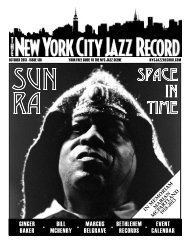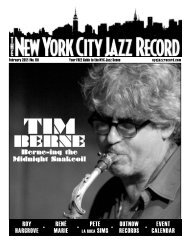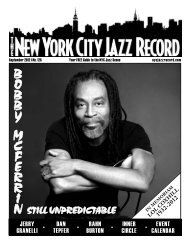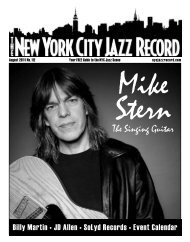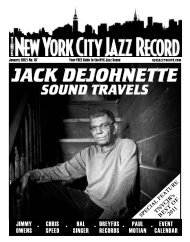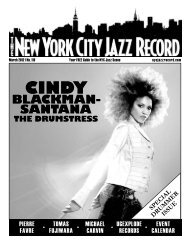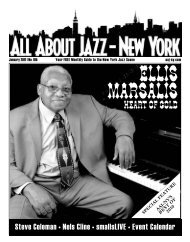Return of the Guitar Man - The New York City Jazz Record
Return of the Guitar Man - The New York City Jazz Record
Return of the Guitar Man - The New York City Jazz Record
Create successful ePaper yourself
Turn your PDF publications into a flip-book with our unique Google optimized e-Paper software.
MEGAPHONE<br />
Allowing for Vibration<br />
by Terrence Mc<strong>Man</strong>us<br />
Seeing as how this issue is dedicated to guitar, when<br />
<strong>the</strong> opportunity to write a piece presented itself, I<br />
couldn’t resist wanting to share some <strong>of</strong> my experiences<br />
in recent years as I began to build guitars. Way before I<br />
ever started playing <strong>the</strong> guitar, just by looking at it and<br />
its parts, I could tell that <strong>the</strong>re were some really rich,<br />
complex interactions happening.<br />
As much as I looked forward to my guitar lessons,<br />
one <strong>of</strong> <strong>the</strong> things that rivaled <strong>the</strong>m was <strong>the</strong> typically<br />
semi-annual trip I took to have my guitar set up. It was<br />
unusual, I think, because <strong>the</strong> person that set up my<br />
guitar allowed me to stay and watch as he did all <strong>the</strong><br />
work, for several hours. I didn’t really know what he<br />
was doing, but I got <strong>the</strong> clear sense that he worked<br />
with a sense <strong>of</strong> purpose and unequivocally knew how<br />
to tweak <strong>the</strong> thing to make it sing.<br />
Something you may not hear at gigs or read about<br />
in general music publications is <strong>the</strong> performing<br />
musician talking about <strong>the</strong> very technical aspects and<br />
relationships <strong>of</strong> <strong>the</strong> construction <strong>of</strong> instrument <strong>the</strong>y<br />
play and <strong>the</strong> varying interaction <strong>of</strong> its components. I’m<br />
sure we’ve all heard saxophonists talking about reeds<br />
and drummers talking about cymbals. But aside from<br />
<strong>the</strong> obvious notion <strong>of</strong> one thing sounding different<br />
<strong>the</strong>n ano<strong>the</strong>r, what exactly is it about <strong>the</strong> particular<br />
item in question and its interaction with <strong>the</strong> rest <strong>of</strong> <strong>the</strong><br />
instrument that is causing it to sound <strong>the</strong> way it does?<br />
Beyond <strong>the</strong> surface level considerations <strong>of</strong> <strong>the</strong><br />
typical A/B comparisons, <strong>the</strong>re exist some true<br />
revelations about sound and vibration through<br />
investigation and study <strong>of</strong> <strong>the</strong> materials involved and<br />
<strong>the</strong>ir interaction. <strong>The</strong> fact that <strong>the</strong>se issues don’t get<br />
talked about too <strong>of</strong>ten may be for good reason. I’ve had<br />
some interesting conversations with guitarists and<br />
o<strong>the</strong>r instrumentalists that really didn’t know, or care<br />
to know, about <strong>the</strong> fundamental or more complex<br />
aspects that make <strong>the</strong>ir instrument operate <strong>the</strong> way it<br />
does. I can certainly understand how one might prefer<br />
to focus on <strong>the</strong> technical performance issues. <strong>The</strong>se<br />
would seemingly be <strong>the</strong> most important things to focus<br />
on as, simply stated, <strong>the</strong>se would seem to be <strong>the</strong> things<br />
that would make one play better. But I can’t help<br />
thinking that having a deep understanding <strong>of</strong> <strong>the</strong> way<br />
one’s instrument actually functions would have a<br />
positive effect on performance.<br />
As I’ve gotten more into <strong>the</strong>se sonic investigations,<br />
I’ve realized a few critical things about my own needs<br />
and tendencies for sound. Maybe <strong>the</strong> most interesting<br />
by Suzanne Lorge<br />
VOXNEWS<br />
Jay Clayton, a singer <strong>of</strong> remarkable depth and ability,<br />
turns 70 this month. Clayton is an unusual musician,<br />
not just for <strong>the</strong> longevity <strong>of</strong> her career and everyouthful<br />
quality <strong>of</strong> her voice, but also for her generosity<br />
<strong>of</strong> spirit as a performer and educator. She inspires both<br />
on stage and <strong>of</strong>f with her talents and presence, always<br />
<strong>of</strong>fering gentle support to <strong>the</strong> established players she<br />
performs with, <strong>the</strong> singers she teaches and <strong>the</strong> up-andcoming<br />
jazz musicians around her.<br />
She is also well schooled. After earning a<br />
bachelor’s degree in music, Clayton moved to <strong>New</strong><br />
<strong>York</strong> in <strong>the</strong> ‘60s from Ohio and quickly became a leader<br />
<strong>of</strong> <strong>the</strong> avant garde scene; her skills as an astute<br />
interpreter <strong>of</strong> <strong>the</strong> spoken word and in free improvisation<br />
led to collaborations with prominent composers like<br />
Steve Reich and John Cage. But it is standards - those<br />
perfectly crafted songs with <strong>the</strong>ir emotion-laden<br />
messages about love and loss—that lay at <strong>the</strong> heart <strong>of</strong><br />
discovery I’ve made is that by continuing to try to<br />
achieve <strong>the</strong> most clear, transparent sound I can, at <strong>the</strong><br />
outset, allows me to go in any sonic direction I wish,<br />
with less limitation. It’s almost as though <strong>the</strong> whiter I<br />
can get <strong>the</strong> canvas, <strong>the</strong> larger <strong>the</strong> canvas size becomes<br />
and similarly colors become more plentiful and deeper<br />
on my palette.<br />
<strong>Man</strong>y times when I am unable to achieve that<br />
initial clear transparency, for whatever reason, it<br />
negatively affects <strong>the</strong> o<strong>the</strong>r seemingly unrelated tones<br />
I may want to get to - <strong>the</strong> ugly sound is less ugly, <strong>the</strong><br />
wet sound is less wet, <strong>the</strong> dense sound less dense.<br />
Without going into too much specific detail<br />
because <strong>of</strong> <strong>the</strong> limits here and because I don’t want to<br />
alienate <strong>the</strong> non-guitar playing readers (are you still<br />
here?), I’d like to share only a few brief observations<br />
about vibration that I find interesting.<br />
<strong>The</strong> wood. One reason <strong>the</strong> old guitars sound so<br />
good is because <strong>the</strong> wood has been stiffening for 50+<br />
years. <strong>The</strong> basic idea involves <strong>the</strong> cellular structure <strong>of</strong><br />
wood and what happens when moisture occupies those<br />
cells, as in newer wood. Needless to say it <strong>of</strong>ten doesn’t<br />
create an ideal vibration medium. Old wood is drier,<br />
more stable, more resonant. Some instrument makers<br />
have even gone so far as to procure reclaimed lumber<br />
to build instruments; some <strong>of</strong> <strong>the</strong>se woods have acted<br />
as <strong>the</strong> beams <strong>of</strong> buildings since <strong>the</strong> mid to late 1800s. It<br />
gives me a great sense <strong>of</strong> wonder to think <strong>of</strong> how rich<br />
<strong>the</strong>se seasoned woods will sound when <strong>the</strong>y are<br />
fashioned into an instrument. Interestingly enough,<br />
even though this is <strong>the</strong> most talked about aspect <strong>of</strong> <strong>the</strong><br />
guitar, which is why I included it first, I don’t<br />
necessarily believe that it is <strong>the</strong> most important.<br />
In brief outline form, here are some things I find to<br />
be as or more important than <strong>the</strong> wood age:<br />
• Wood weight/density and its effect on resonance<br />
• Finish thickness and constitution<br />
• Stability <strong>of</strong> contact points and <strong>the</strong>ir<br />
materials/constitution<br />
• Magnetic pickup construction/setup<br />
• String tension<br />
In more recent investigations, I’ve been studying<br />
<strong>the</strong> actual weight <strong>of</strong> <strong>the</strong> individual string tension<br />
relationships and have even gone so far as to create my<br />
own sets <strong>of</strong> strings, to create an even feel and string<br />
tension weight from string to string. Again, by creating<br />
a more balanced environment, it allows for more<br />
vibration to occur.<br />
Ano<strong>the</strong>r interesting consideration, something that<br />
I have done for a long time, is that I mostly play <strong>the</strong><br />
electric guitar unamplified when practicing. In reality,<br />
<strong>the</strong> amplifier is probably just as important to <strong>the</strong> sound<br />
her work. She insists that <strong>the</strong> message drives <strong>the</strong> song,<br />
even if one is soloing wordlessly over a tune. “It’s<br />
important to be true to <strong>the</strong> story we’re telling,” she<br />
told me in an interview almost three years ago. “If<br />
<strong>the</strong>re’s a word, you have to believe that word.”<br />
Her <strong>New</strong> <strong>York</strong> birthday concert will be sponsored<br />
by Arts for Arts Inc. at <strong>the</strong> Clemente Soto Vélez<br />
Cultural Center on Dec. 5th. Check her website<br />
(jayclayton.com) for details <strong>of</strong> this celebration and<br />
o<strong>the</strong>rs - <strong>the</strong> jazz parties in her honor continue for a<br />
couple <strong>of</strong> months (as <strong>the</strong>y should).<br />
Tierney Sutton and her top-notch band depart<br />
slightly from <strong>the</strong> usual with American Road (BFM <strong>Jazz</strong>),<br />
a collection <strong>of</strong> Americana-infused songs like “Oh,<br />
Shenandoah/<strong>The</strong> Water Is Wide”, “Amazing Grace”<br />
and “America <strong>the</strong> Beautiful”. <strong>The</strong> album is, to be brief,<br />
gorgeous and it reminds us just how remarkable <strong>the</strong><br />
American musical experiment has been. Sutton, with<br />
her clear, imaginative vocals, is an excellent steward <strong>of</strong><br />
this tradition.<br />
as <strong>the</strong> guitar. In fact, I think Wes Montgomery said as<br />
much, something to <strong>the</strong> effect that his instrument was<br />
<strong>the</strong> guitar and <strong>the</strong> amplifier. While I do subscribe to<br />
this type <strong>of</strong> thinking, that <strong>the</strong> amplifier is <strong>of</strong> somewhat<br />
equal importance, I have found that by first sculpting<br />
<strong>the</strong> sound <strong>of</strong> <strong>the</strong> unamplified guitar, it <strong>the</strong>n allows for<br />
<strong>the</strong> amplifier to enhance and broaden <strong>the</strong> clear,<br />
transparent sound I have tried to create. Which can<br />
<strong>the</strong>n begin to be abstracted as/if I see fit.<br />
One important lesson that I have learned is that by<br />
having a greater understanding <strong>of</strong> how <strong>the</strong> instrument<br />
works and having a cursory to above average<br />
knowledge <strong>of</strong> how to make repairs and upgrades, I<br />
greatly increase my sensitivity to <strong>the</strong> instrument,<br />
which in turn allows me to develop a closer relationship<br />
to it and ultimately allows me to be a better performer.<br />
This issue <strong>of</strong> sensitivity is not relegated just to playing<br />
<strong>the</strong> guitar. By becoming sensitive to <strong>the</strong> sound <strong>of</strong> <strong>the</strong><br />
guitar, I feel that has made me a more sensitive listener<br />
and in turn more sensitive to what is happening on <strong>the</strong><br />
bandstand. I’ve come to realize after <strong>the</strong>se many years<br />
<strong>of</strong> studying <strong>the</strong> guitar and <strong>the</strong> physical relationship <strong>of</strong><br />
its various components, being sensitive to sound opens<br />
up a sensitivity to listening, touch, hearing, space,<br />
interaction, pacing.<br />
I remember a master class that I attended by Adam<br />
Nussbaum in high school. He said something very<br />
interesting that I sometimes think about. He said, if<br />
you keep thinking about <strong>the</strong> sound you want and keep<br />
hearing it in your head, eventually you will produce<br />
that sound. Personally, because I don’t always want to<br />
have <strong>the</strong> same sound, I don’t necessarily always think<br />
about getting <strong>the</strong> same sound. But what I get from his<br />
thought is to keep thinking deeply about sound and<br />
vibration. <strong>The</strong> more you really consider and understand<br />
sound and vibration and understand <strong>the</strong>ir nature on<br />
your instrument, <strong>the</strong> more sensitive you become to<br />
yourself and everything around you. v<br />
For more information, visit terrence-mcmanus.com.<br />
A Brooklyn native, guitarist/composer/teacher Terrence<br />
Mc<strong>Man</strong>us has performed or recorded with John Zorn, Bill<br />
Frisell, Tim Berne, Don Byron, John Hollenbeck, Ellery<br />
Eskelin, Herb Robertson, Mark Helias and Gerry<br />
Hemingway. In 2008 Mc<strong>Man</strong>us was featured in <strong>the</strong> book<br />
State <strong>of</strong> <strong>the</strong> Axe: <strong>Guitar</strong> Masters in Photographs and<br />
Words by legendary photographer Ralph Gibson. An<br />
accomplished solo guitarist, Mc<strong>Man</strong>us performs his own<br />
works on electric and classical guitar and has developed a<br />
unique style <strong>of</strong> improvisation, drawing on extended<br />
technique and prepared guitar. His first solo recording,<br />
Brooklyn EP, was self-released in 2010.<br />
Bassist Christian McBride has turned out a stellar<br />
big band release (his first) with <strong>The</strong> Good Feeling (Mack<br />
Avenue), featuring Melissa Walker, a charming singer<br />
with a rich voice and a natural way with a phrase. She<br />
doesn’t appear on all <strong>of</strong> <strong>the</strong> cuts - <strong>the</strong> band and<br />
McBride’s arrangements are <strong>the</strong> main event here - but<br />
her moments in <strong>the</strong> forefront shine.<br />
If you love free improv but can’t make it to Jay<br />
Clayton’s birthday party, pick up a copy <strong>of</strong> From<br />
Granite To Wind (Ogun), with <strong>the</strong> Keith Tippett Octet<br />
and vocals/poetry by Julie Tippetts. One snippet:<br />
“Songs—like birds—enflutter my pulse and ring—in<br />
<strong>the</strong> air.” Word!<br />
October gigs: Cassandra Wilson is at Rose <strong>The</strong>atre<br />
Oct. 1st; Tessa Souter sings at Joe’s Pub Oct. 8th; Amy<br />
Cervini presents her regular monthly shows at 55Bar -<br />
for adults Oct. 20th and for kids Oct. 9th and 23rd;<br />
Kurt Elling appears at Birdland Oct. 25th-30th and<br />
Nikki Yan<strong>of</strong>sky takes a giant step in her young career<br />
with her debut at <strong>the</strong> Allen Room Oct. 28th-29th. v<br />
THE NEW YORK CITY JAZZ RECORD | October 2011 11



